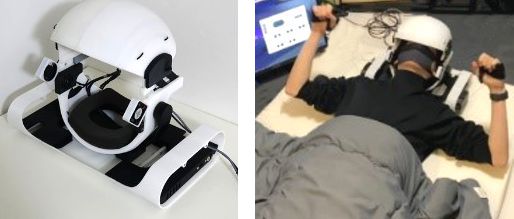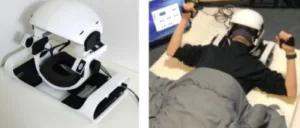Founded just recently, in March, 2021, Diver-X, Inc. (Tokyo, Japan) is in the process of launching a rather unusual headset. Called the HalfDive, the product is designed for use while the user is lying down. That is, the headset is represented as “perfect for in-bed VR gaming.” In fact, the company has referred to this class of product as a “Bed Mounted Display” or BMD.

In order to make the headset comfortable to use while lying down, it is integrated into what the company calls a base station. (See the figure below.) Once the user lies down and rests their head on the pillow-like pad of the base station, the headset can then be lowered into position over the user’s face. In this configuration, the headset exerts almost no pressure on the user’s face and leads to the claim that the headset is comfortable to wear for an extended period of time. A second factor supporting the comfort claim is that the headset was designed to fit 99% of all human head sizes, according to international head measurement data.
The system implements a limited range of user inputs and force feedbacks in part by cuffs worn on the user’s hands. The cuffs are connected by cables to a HalfDive tracker unit. The force feedback feature can operate in either an Automatic or a MOD mode. The Automatic mode works with all content. In the MOD mode, Diver-X or a third parties’ program modifies the force feedback manually.
Interestingly, the system also includes foot mounted controllers. The input derives from the degrees of tilt of the user’s ankles. This unique tracking system allows the user to express body movements “equivalent to standing even when lying down.”
HalfDive’s stationary configuration also enhanced the ability of the headset’s designers to add various feedback devices into the headset. Such devices would be difficult to include in a conventional virtual reality headset due to size and weight restrictions.
One such feature is wind feedback. Wind is implemented by two fans that are located on the upper inside of the headset. Beyond feedback, the fans can be used just to enhance user comfort. A second additional feature is a vibration feedback system that is powered by an exciter.
A video appended to the end of this article provides an introduction to the set up and operation of the HalfDive headset. The figure below illustrates the HalfDive Headset in the base station and in use.
 Left: The HalfDive headset and the base station. Right: The Headset in use. Note that the user is holding controllers.
Left: The HalfDive headset and the base station. Right: The Headset in use. Note that the user is holding controllers.
Some of the features and specification of the HalfDive headset are as follows:
- LCD display resolution: two displays each with 1,440 X 1,600
- Refresh rate: 90 Hz
- Lens: 10 element aspheric lenses
- Field of View: estimated at 134 degrees
- IPD: dial adjustable from 58 to 84 mm
- DisplayPort 1.2
- USB 3.0
- 5 mm audio jack
- 12 V power source
- I2C (module connection)
- Four speaker provide an “immersive, 3D” sound system. The audio is processed by HalfDive, not by a PC, so the user can also listen to their smartphone’s audio through the HalfDive itself.
- Microphone
- System requirement: Windows 10 (Linux support is expected.)
- Dual Core CPU with hyper-threading
- 8GB RAM
- Nvidia GeForce GTX970 / AMD RX 480
- Cables for video transmission can be attached and detached at the side.
All of HalfDive’s modules and feedback systems are designed to be exchangeable and/or extensible. As an example, the user could exchange the display that is included with the headset for a higher resolution display.
HalfDive is compatible with SteamVR thanks to OpenVR integration. Having said that, it is unclear the extent to which using HalfDive would provide a satisfactory experience when playing most SteamVR titles. The concern is that rotational movements do not seem to be natural when the user is reclining. Perhaps watching movies or more passive apps would be more suitable. HalfDive is also compatible with Unity and the Unreal engine. OpenXR is not currently supported but may become so in the near future.
The company plans to release a SDK providing as open source the designs and programs associated with HalfDive’s body and modules. By this means, users with access to 3D Printers could further enhance their VR experience by creating original modules that fit HalfDive’s design. Users with programming capability could add to the program.
Two HalfDive headset models will be available. The Minimum Model comes in at an Early Bird price of $750 and includes a HalfDive headset, hand controllers and a HalfDive Tracker. The more expensive Basic Model at $1050 adds the Force and Wind Feedback modules. The vibration feedback module comes standard with every HalfDive.
Shipping of the headset was set for August 2022.
(At this point, we had the article edited and due for publication. However, just as we were finalising the article and on the last day of the Kickstarter project, which had raised $222K against a target of $174K, the company cancelled the Kickstarter projects – Editor).
On cancellation, the firm said that it realised that it had not really reached its goal of transforming the in-bed work and gaming experience. It also found that building the headset and optics took a lot more cash and had a higher cost than expected and it has basically run out of cash.
The firm said:
“We have decided that even if we continue with our Kickstarter project and receive your kind support, there is a high possibility that we will not be able to provide you with the experience that HalfDive claims to offer, complete production, and in the worst case, deliver our product to your hands, and lose your trust in us as a company.”
It wants to continue the development, so, as the saying has it, ‘watch this space’. -Arthur Berman

